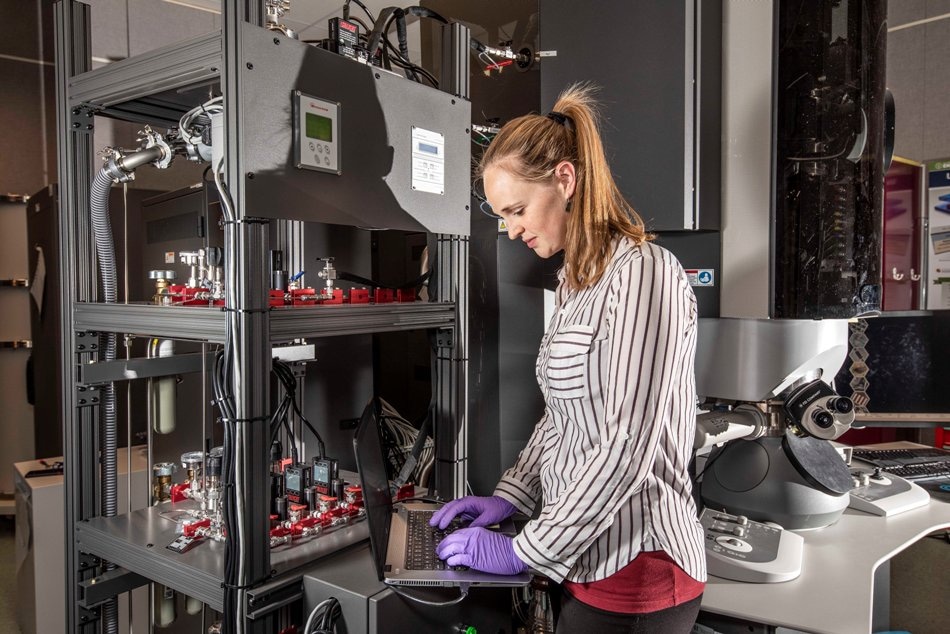Jun 7 2019
Steel pipes tend to rust and sooner or later fail. To anticipate disasters, oil companies and others have developed computer models to foretell when replacement is necessary. However, if the models themselves are incorrect, they can be amended only through experience, an expensive problem if detection happens too late.
 Sandia National Laboratories researcher Katherine Jungjohann, principal investigator and lead microscopist for a study that pinpointed a major cause of corrosion in pipelines, looks for corrosion with a new transmission electron microscope at the Center for Integrated Nanotechnologies. The gas valves on the shelves at left produce different testing environments. (Photo credit: by Randy Montoya)
Sandia National Laboratories researcher Katherine Jungjohann, principal investigator and lead microscopist for a study that pinpointed a major cause of corrosion in pipelines, looks for corrosion with a new transmission electron microscope at the Center for Integrated Nanotechnologies. The gas valves on the shelves at left produce different testing environments. (Photo credit: by Randy Montoya)
Currently, scientists at Sandia National Laboratories, the Department of Energy’s Center for Integrated Nanotechnologies and the Aramco Research Center in Boston, have discovered that a specific form of nanoscale corrosion is responsible for suddenly diminishing the working life of steel pipes, according to a paper recently published in Nature’s Materials Degradation journal.
Using transmission electron microscopes, which shoot electrons through targets to capture pictures, the scientists were able to spot the root cause of the problem on a triple junction created by a grain of cementite — a compound of iron and carbon— and two grains of ferrite, a type of iron. This junction forms often during most approaches of making steel pipe.
Iron atoms slip-sliding away
The scientists learned that interfacial disorder in the atomic structure of those triple junctions made it convenient for the corrosive solution to eliminate iron atoms along that interface.
In the experiment, the corrosive process did not progress further when the triple junction had been consumed by corrosion, but the crevice left behind enabled the corrosive solution to damage the interior of the steel.
“We thought of a possible solution for forming new pipe, based on changing the microstructure of the steel surface during forging, but it still needs to be tested and have a patent filed if it works,” said Sandia’s chief investigator Katherine Jungjohann, a paper author and lead microscopist. “But now we think we know where the major problem is.”
This was the world’s first real-time observation of nanoscale corrosion in a real-world material — carbon steel — which is the most prevalent type of steel used in infrastructure worldwide. Through it, we identified the types of interfaces and mechanisms that play a role in the initiation and progression of localized steel corrosion. The work is already being translated into models used to prevent corrosion-related catastrophes like infrastructure collapse and pipeline breaks.
Steven Hayden, Senior Research Scientist, Aramco Research Center
To imitate the chemical exposure of pipe in the field, where the costly, delicate microscopes could not be shifted, very thin pipe samples were exposed at Sandia to a range of chemicals identified to pass through oil pipelines.
Sandia scientist and paper author Khalid Hattar placed a dry sample in a vacuum and used a transmission electron microscope to develop maps of the steel grain types and their orientation, much like a pilot in a plane might use a camera to develop area maps of roads and farmland, except that Hattar’s maps had about 6 nm resolution. (One-billionth of a meter makes a nanometer.)
“By comparing these maps before and after the liquid corrosion experiments, a direct identification of the first phase that fell out of the samples could be identified, essentially identifying the weakest link in the internal microstructure,” Hattar said.
Sandia researcher and paper author Paul Kotula said, “The sample we analyzed was considered a low-carbon steel, but it has relatively high-carbon inclusions of cementite which are the sites of localized corrosion attacks.
“Our transmission electron microscopes were a key piece of this work, allowing us to image the sample, observe the corrosion process, and do microanalysis before and after the corrosion occurred to identify the part played by the ferrite and cementite grains and the corrosion product.”
When Hayden initially began working in corrosion research, he said, “I was daunted at how complex and poorly understood corrosion is. This is largely because realistic experiments would involve observing complex materials like steel in liquid environments and with nanoscale resolution, and the technology to accomplish such a feat had only recently been developed and yet to be applied to corrosion. Now we are optimistic that further work at Sandia and the Center for Integrated Nanotechnologies will allow us to rethink manufacturing processes to minimize the expression of the susceptible nanostructures that render the steel vulnerable to accelerated decay mechanisms.”
Invisible path of localized corrosion
Localized corrosion is not the same as uniform corrosion. The latter happens in bulk form and is very predictable. The former is imperceptible, creating a pathway observable only at its endpoint and increasing bulk corrosion rates by rendering it easier for corrosion to advance.
“A better understanding of the mechanisms by which corrosion initiates and progresses at these types of interfaces in steel will be key to mitigating corrosion-related losses,” according to the paper.
Other authors include Sandia scientists William Mook and Daniel Bufford and former Sandia researcher and experimental lead Claire Chisholm, who is currently at the University of California at Santa Barbara.
The research was sponsored partly by Sandia’s Laboratory Directed Research and Development program. The Center for Integrated Nanotechnologies is a DOE Office of Science user facility run by Sandia and Los Alamos national laboratories for university, industry, and other national lab scientists.